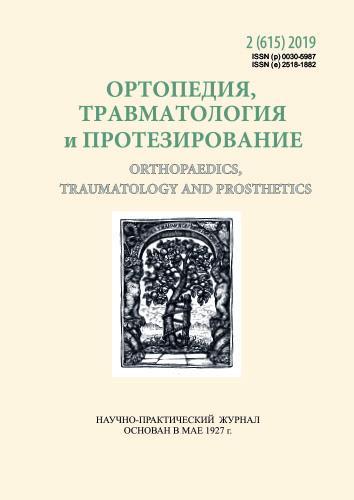Computer simulation and field study of the stress-strain state of the biomechanical system «fixator-bone» at supramalleolar corrective osteotomies
DOI:
https://doi.org/10.15674/0030-59872019218-26Keywords:
supramalleolar corrective osteotomy, ankle joint, computer simulation, full-scale bench researchAbstract
Objective: to study the stability of internal fixation at various types of the supramalleolar corrective osteotomies of the distal tibia bone. To examine the parameters of stiffness and durability of the «fixator-bone» systems at computer simulation by finite elements method; to assess the adequacy of this method by comparisons with the results of field full-scale studies.
Methods: the 3D distal tibia bone model is based on the CT of an intact tibia in the ANSYS software package. In-situ study we used 5 intact distal tibia bone species of dead people. In the models we recreated supramalleolar corrective osteotomies specified zones with fixation with various blocked plates with angular stability.
Results: systems with medial blocked «puddi-plate» and anterior lateral blocked L-shaped plates had the highest stiffness and stability. The allowable efforts for compression were 217 and 308 N, for bending — 34 and 73 N, for torsion — 18.8 and 17.9 N/m, respectively. The smallest compressive stiffness (151 N), bending (19 N) and torsion (2.46 N/m) were found at a medial blocked plate. Similar distribution of maximal static and cyclic loads was obtained in full-scale bench research.
Conclusions: the adequacy of imitation 3D-models and parameters of biological materials incorporated in them was confirmed. In the case of a medial supramalleolar corrective osteotomies with an open wedge, the medial blocked plate «puddi-plate» provided the greatest stability and rigidity of fixation. For lateral supramalleolar corrective osteotomies with closed wedge and anterior focal dome correcting osteotomies — optimally used anterior-lateral L-shaped blocked plate.
References
- Colin, F., Bolliger, L., Horn Lang, T., Knupp, M., & Hintermann, B. (2014). Effect of supramalleolar osteotomy and total ankle replacement on talar position in the varus osteoarthritic ankle. Foot & Ankle International, 35 (5), 445–452. doi: 10.1177/1071100713519779
- Schmid, T., Zurbriggen, S., Zderic, I., Gueorguiev, B., Weber, M., & Krause, F. G. (2013). Ankle joint pressure changes in a pes cavovarus model. Foot & Ankle International, 34 (9), 1190–1197. doi: 10.1177/1071100713500473
- Colin, F., Gaudot, F., Odri, G., & Judet, T. (2014). Supramalleolar osteotomy: Techniques, indications and outcomes in a series of 83 cases. Orthopaedics & Traumatology: Surgery & Research, 100 (4), 413–418. doi: 10.1016/j.otsr.2013.12.027
- Kim, Y. S., Park, E. H., Koh, Y. G., & Lee, J. W. (2014). Supramalleolar osteotomy with bone marrow stimulation for varus ankle osteoarthritis. The American Journal of Sports Medicine, 42 (7), 1558–1566. doi: 10.1177/0363546514530669
- Omelchenko, T. M., Buryanov, O. A., Lyabakh, A. P., Mazevich, V. B., Musienko, O. S., & Shidlovskiy, M. S. (2017). Physical and mechanical properties of the trabecular bone tissue of the ankle bones (experimental and clinical study). Bulletin of orthopedics, traumatology and prosthetics, 2, 66–72. (in Ukrainian)
- Omelchenko, Т. М., Buryanov, О. А., Lyabakh, А. Р., Mazevich, V, . Shidlovsky, M., & Musienko O. (2018). Correlation of elastic modulus and x-ray bone density in the area of the ankle joint. Orthopaedics, Traumatology and Prosthetics, 3, 80–84. doi: 10.15674/0030-59872018380-84. (in Ukrainian)
- Yeshchenko, V. O. (2013). Imitation modeling of the stress-strain state of biomechanical systems for bones of the limbs and jaw of a person with injuries. Bulletin of NTUU «KPI», 2 (68), 84–90. (in Ukrainian)
- ISO 5832-3:2016. (n.d.). Retrieved from www.iso.org/standard/66637.html
- SOLID187. (2015, December 2). Retrieved from www.sharcnet.ca/Software/Ansys/17.0/en-us/help/ans_elem/Hlp_E_SOLID187.html
- Ellington, J. K., & Myerson, M. S. (2013). Surgical correction of the ball and socket ankle joint in the adult associated with a talonavicular tarsal coalition. Foot & Ankle International, 34 (10), 1381–1388. doi: 10.1177/1071100713488762
- Knupp, M., Barg, A., Bolliger, L., & Hintermann, B. (2012). Reconstructive surgery for overcorrected clubfoot in adults. The Journal of Bone and Joint Surgery. American Volume, 94 (15), e1101–11017. doi: 10.2106/jbjs.k.00538
- De Roode, C. P., Hung, M., & Stevens, P. M. (2013). Supramalleolar Osteotomy. Journal of Pediatric Orthopaedics, 33 (6), 672–677. doi: 10.1097/bpo.0b013e31829d1a9a
- Eidelman, M., Katzman, A., Zaidman, M., & Keren, Y. (2011). Deformity correction using supramalleolar gigli saw osteotomy and Taylor spatial frame. Journal of Pediatric Orthopaedics B, 20 (5), 318–322. doi:10.1097/bpb.0b013e328345d877
Downloads
How to Cite
Issue
Section
License
Copyright (c) 2019 Taras Omelchenko, Oleksandr Buryanov, Andriy Lyabakh, Mykola Shidlovkiy, Viktor Yeshchenko, Mariana Dyman

This work is licensed under a Creative Commons Attribution 4.0 International License.
The authors retain the right of authorship of their manuscript and pass the journal the right of the first publication of this article, which automatically become available from the date of publication under the terms of Creative Commons Attribution License, which allows others to freely distribute the published manuscript with mandatory linking to authors of the original research and the first publication of this one in this journal.
Authors have the right to enter into a separate supplemental agreement on the additional non-exclusive distribution of manuscript in the form in which it was published by the journal (i.e. to put work in electronic storage of an institution or publish as a part of the book) while maintaining the reference to the first publication of the manuscript in this journal.
The editorial policy of the journal allows authors and encourages manuscript accommodation online (i.e. in storage of an institution or on the personal websites) as before submission of the manuscript to the editorial office, and during its editorial processing because it contributes to productive scientific discussion and positively affects the efficiency and dynamics of the published manuscript citation (see The Effect of Open Access).














